Sorry this is long...
I was asked to give some of my insights as to what I see in the gun control discussion. Something to understand is guns have been a part of my life back to my early youth (5 years old or so). I was given my first rifle when I was 12. I was a firearms coach at the Naval Academy for incoming freshmen (Plebe summer). I have qualified expert multiple times with handgun and rifle over the years. I am an NRA certified pistol instructor and Range Safety Officer. But…I am labeled a “thinker” by some that know me. That means I like to think of myself as open to new ideas and my mind can be changed. I do not follow blindly, but rather come to my own conclusions. This subject is something I’m passionate about for many reasons, but the below is written in an attempt to minimize emotions.
I see the gun control debate homed in a number of concepts or issues…but have run out of energy for the night. Here are a little of my ramblings I have written on the subject.
1. The Constitution
The main argument back and forth is the definition of the Second Amendment. There have been numerous debates on the significance of the wording and punctuation. Most in favor of guns believe there are two separate statements where the “well regulated militia” and the “right of the people to keep and bear arms”, where the right of the people is the meat of the Amendment.
The other side of the argument is the focus on the well regulated militia, with the standing Army and/or National Guard fulfilling the role of the militia.
Taken as it stands, there is no clear interpretation. However, there are other documents from the period written by framers of the Constitution. I look to the Federalist papers and others as a good reference for the thoughts behind the Amendment. Most refer to the right to bear arms as a means to protect oneself, in some cases from a tyrannical government. These statements are founded in the Crown’s attempt to disarm the colonies just prior to the Revolution. I have seen little to refute this.
Are people afraid of a Government they can’t resist? We are a nation ruled by the people, for the people. Our elected representatives are meant to be servants of the people, rather than ruling the people. What keeps the government in check if the people have no check on the government?
There is an argument that the Second Amendment is outdated; we no longer need to fear our government. This may be a fair argument. We have fair transparency worldwide, with international opinion ruling much of what we do. Our government will not easily turn to oppression. So why do the people need protection from the government?
2. If the government is no longer a threat, society still is. There are bad people out there.
My wife is a brown belt in karate and Judo, yet during one self-defense class I was working with her and wanted her to need to do the move right and resisted. Even though she has a decent background in the concepts and skills, my larger size and strength were enough to allow me to stand there unmoved by her attempts.
In my own experiences…I am a now second degree black belt in karate and green belt in Marine Corps Martial Arts. I’m not exactly small, and have held my own against opponents in the pursuit of these titles. While working with the Marines I was able to hold my own against even bigger people as long as my skills and experience were higher than theirs. When it came to working one on one with the black belt instructors, and getting within arms’ reach, even the 5’8” 170 lbs Marine could eventually take me down while the 6’2” 220lbs Marine could take me in seconds.
While the best defense is to not be there (ie. Avoid the situation completely), it is not always possible. A firearm does two things for a person. The first is providing the protection of distance. A handgun is effective at 6 inches or 30 feet. The second thing it provides is equality. A 5’ tall woman with a handgun is a lot more equal to a 6’+ attacker than if she was unarmed (see above where Heather couldn’t throw me).
So what about non-lethal methods like pepper spray? First, range is limited to a lot less than a gun. Second, there is a higher chance of accidental exposure because of wind or splashing. Third, there is a limit to how many “shots” you get with pepper spray. Keep that in mind when considering typical assault statistics that show the average assault has three attackers. A taser is worse than pepper spray because only the first shot is at distance – follow up shocks must be at arms’ distance or less.
3. High Capacity magazines
There are several arguments against high capacity magazines for both rifles and pistols. The main one is the ability to have “so many” shots at your disposal with high capacity magazines. My first issue here is the definition of high capacity. It is an arbitrary number. The Beretta 92FS (M9 in military designation) has a STANDARD capacity of 15 rounds. That means as designed and built, the magazine holds 15 rounds. A 10 round magazine is actually a reduction from standard capacity to something less. What I would classify as high capacity is something like the Glock used against Congresswoman Giffords that had 30 (33?) round magazines. Why are there magazines that size for a gun? Mostly because of the pistol competition world where a 1/4 advantage means a difference of 1st or 2nd place.
So what’s the big deal about capacity? Why can’t gun owners be OK with 10 rounds? Let’s start with the three attackers in an assault. The point of shooting someone is to shut them down. This can be disrupting their nervous system or some other major system like respiration or circulation. The brain will shut down if it is overloaded or is no longer receiving enough oxygen.
So what does it take to cause this disruption? It usually takes more than one shot. Recently a mother was forced to defend herself from a single attacker in her home. She was hiding in a closet hoping he would go away. Instead he found her and she unloaded 5 of six shots into him from her revolver, yet he was still able to stand up and walk away to be arrested later. That’s five shots to the body, from close range. What if it was three attackers? An expert (Jerry Miculek) can reload a revolver in less than a second. I know I can’t.
If that person is on drugs, it could be worse. There have been stories of law enforcement being faced by a crack/meth head that was absolutely crazed and still coming at them after being shot by over 10 rounds from a service pistol.
4. Why do we need military-style rifles?
Let’s go back to that part where we are defending ourselves from a tyrannical government. In that vein, we should be as well armed as the military. Does that include tanks, Apache/Cobra helicopters, and the like? Well, some of that was decided per the National Firearms Act of 1934, and revised with the NFA of 1968 (good info on Wikipedia: http://en.wikipedia.org/wiki/National_Firearms_Act). The foundation in 1934 was to counter gangsters, but in 1968 was refined and starts to include “destructive devices” which addresses many of what I consider to be absurd questions regarding owning an M1 Abrams, etc.
Now we can address the title of assault rifle. An Assault Rifle is a rifle that has “select fire” capability. This means the typical rifle will have three settings: safe, semi-auto, and auto/burst. Semi-automatic is defined as one round is fired for each pull of the trigger. Automatic and burst both result in multiple rounds fired for each pull of the trigger. This could be firing until the trigger is released or the typical burst of 3 rounds. Early M-16’s had the fully automatic capability, but were changed later to 3 round burst because full auto is difficult to control. Even 3 round burst is less than ideal except when used as covering fire (shooting in the general vicinity of the bad guys to keep them from shooting back as someone moves from behind cover). Firearms that fall into this category, while not illegal to own, are very limited in availability. In fact, the only way to legally own an automatic rifle, without being law enforcement or fitting other very specific categories, is if the rifle was made and registered prior to May of 1986.
There is something to understand about military arms. Throughout American history military and civilian arms have progressed in lock step. In many cases, civilian arms were ahead of military arms. Advances in the civilian technology were quickly adopted, and vice versa. Ignoring technology, most improvements in marksmanship have been made on the civilian side and transitioned to the military. This is most evidenced by the pistol competition community in the last 40 years. IDPA and IPSC have transformed the training our military receives, making them a more effective fighting force even though pistols have remained basically unchanged since the military’s adoption of the M1911 handgun 102 years ago.
The term “Assault Weapon (AW)” is poorly defined. In 1994, Senator Diane Feinstein’s Assault Weapons Ban (AWB) was based on cosmetic criteria. What kinds of things? If the rifle had two or more of the following it was classified as an AW: Bayonet lug, flash hider, pistol grip, collapsible/folding stock, or grenade launcher. Even the Violence Policy Center agrees the criteria were cosmetic. This image is of two rifles that are functionally identical, but one meets the letter of the law for a 1994 AW http://modernsurvivalonline.com/wp-content/uploads/2010/08/ruger_banner.jpg. It fires a .22 long rifle round, which is the exact same round the Boy Scouts of America allow boys 10 and older to shoot. It’s low power, and easy to shoot.
The main point of contention from the gun lobby is the fact that there has been no increase in firearms related crimes since the sunset/expiration of the 1994 AWB. In fact, in 2011 there were just over 350 crimes committed with ANY rifle, let alone a poorly defined assault weapon. This means rifles make up less than 4% of all firearms related murders.
So why are they such a “target”? Part of it is they are certainly scary looking. Another is that any rifle is more effective than a pistol. They can be used at short or long range. The bullet may be smaller, but higher velocity can make it as effective or more effective. Despite all of that, they are not prevalent most likely because they can not be easily concealed like one or more handguns can.
5. But the AR-15 has no sporting use.
First, the Second Amendment does not say anything about hunting, sporting, etc. Second, yes, the AR-15 has sporting use. The AR-15 is a flexible platform that is widely used in both hunting and shooting sports. There are “varminter” versions that are extremely accurate and used on anything from prairie dogs to coyotes. The platform has evolved to the point the AR can be used with numerous calibers making it suitable for even large game (deer, elk, etc). Do I need 30 rounds for that? Nope. No ethical hunter will take a shot where he only hopes to hit the prey. In many states it is illegal to use a rifle that can have more than a handful of rounds loaded, so hunters use smaller magazines that hold 5 or 10 rounds.
Continuing the thread above regarding civilian competition improving tactics, techniques and procedures, the AR-15 as a platform is used heavily in high power competition (traditional long range marksmanship) as well as “three gun” which is a combination of pistol, shotgun and rifle use as the shooter moves from station to station testing a balance of skills across several firearms. NBC Sports even has (had?) a TV show about it called “3-gun Nation”.
6. So what about gun control? Why shouldn’t we have it?
Some look at “reasonable gun control” as the beginning of the end, depending on the definition of reasonable. We can look to Australia as a recent example of what gun registration and gun control brought. Initial controls that did not “sufficiently curtail” gun crimes, the laws became more and more strict until nearly all firearms have been banned. Piers Morgan uses England and Wales as the example of what life could be like without guns. Last year there were less than 40 deaths from guns. He fails to mention, though, that the violent crime rate is more than double that of the United States. So while they do have less gun crimes, they have significantly higher violent crime overall.
We have 49 states with concealed carry laws, 40 of which are shall issue or constitutional where a non-prohibited citizen may carry concealed without a permit. Why is it states like Florida, the first to enact concealed carry permits in 1987, has seen a consistent decrease in crime over the last 25 years?
The biggest hurdle to any new legislation is the inability to find a middle ground. The 1994 AWB did not do anything to decrease crime, as evidenced by the lack of increase when it ended. Senator Feinstein’s line of thinking now is that it didn’t go far enough, which is why it wasn’t effective. Her basic outline for proposed legislation makes most (all?) semi-automatic firearms to include rifles, shotguns, and handguns, either outright illegal or required to be registered in accordance with the NFA. They would also be illegal to transfer to any other person. Ever. Once the owner dies, the guns would have to be turned in to the government for disposal. Governor Cuomo went so far as to use the word “confiscation”.
Why should law abiding citizens subject themselves to being disarmed? The criminals certainly won’t turn their guns in. My estimate is it would take either house to house searches across the nation to hope to come close to getting all the guns in less than several decades, but violent crime will increase year after year.
7. So what would I do?
I would start by enforcing existing laws. Then…
a. Go ahead and require background checks for ALL transfers of firearms. There’s no reason my FBI NICS check couldn’t be tied to my driver’s license. Allow a check of someone’s legal ability to purchase a gun through the simple submission of driver’s license info on a web site.
b. Make the initial purchase of a firearm require a 10 day wait nationwide. All subsequent purchases can be made without a wait. After all, why do I need a cooling off period if I already own a gun?
c. Include basic firearms training for all children at approximately 7-8 yrs of age. Eliminating the mystique of guns and increasing awareness of safety/consequences would cut down a lot on accidental deaths.
d. Make concealed carry a nationally reciprocated item. A license in one state is good in any. This would require some national minimum standard.
e. Get rid of Gun Free Zones. A legally carried gun is no threat to anyone, and a criminal will not only ignore it, but the last Aurora shooting shows the bad guy will seek it out.
f. I have no idea what to do about the mental health aspect of this discussion. It’s a concern, but I see it as a larger discussion than gun control, with no easy answer.
Tuesday, January 15, 2013
My take on the gun control conversation
Sunday, August 1, 2010
Ft Jackson/Camp McCrady
Day 1:
Meet the Drill Sergeants. Get on buses. Get gear - body armor, back pack, framed pack, and a couple of other things. Get on buses again, go 1/4 to 1/2 a mile away, get more gear - EyePro (Eye Protection - two sets ESS glasses with two lenses each, plus a set of goggles and lenses), ACU Camelback, camelback cleaning kit, warm and cold weather gloves, helmet (AKA kevlar or Advance Combat Helmet - ACH), knee and elbow pads, etc. Afghanistan gets a lot more gear than Djibouti - I have no idea what they got extra other than the Extreme Cold Weather System. Inventory the gear while staged in a circle. One sea bag (or two for Afghanistan) is no-need, the other is the need bag. The DS's tell you what goes in each. They're pretty accurate on this one.
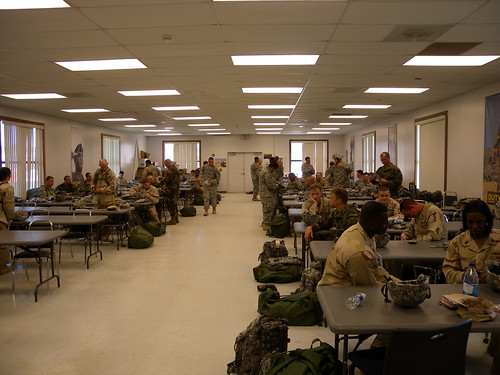
Day 2:
Some stuff....but this is when you get issued your weapons. Officers get both M16/M4 and M9. Enlisted get at least an M16/M4 but some get M9 as well. It depends on Noble Eagle number. Same with M4 vs M16. The M4 is issued if you'll be doing a lot of convoy ops. These weapons will be with you everywhere except the M16 doesn't go to the head with you (for some reason the DS's call it a latrine. Go figure ;)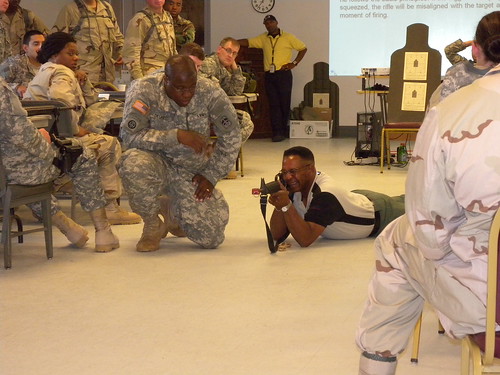
Day 3:
After day two, the focus is pretty much on shooting and safety. We got a lot of range time. Before we went to the range, we went to the Engagement Skills Trainer.
Think duck hunt or some other computer game. They had M16's, M4's, M9's and about any other weapon, in these things. We used the EST to learn how to group and zero our rifles. We also used it to do our low light M9 training. They use compressed air to operate the actions on the weapons and the computer makes the process foolproof. It is, however, also unforgiving.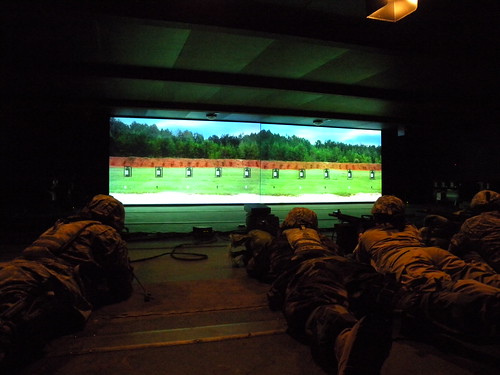
We finished this day off by going to the HEAT trainer. This is a HumVee egress trainer for rollover situations. You get in and everything is normal. The trainer leans one way a few degrees (OK...a lot of degrees), then the other, then it flips over onto its top. Now you're hanging upside down by your seat belt and have to safely get out and post security to your corner. Following this we got a familiarization lecture on the HumVee, followed by a change to rotate through the different positions to get a feel for it.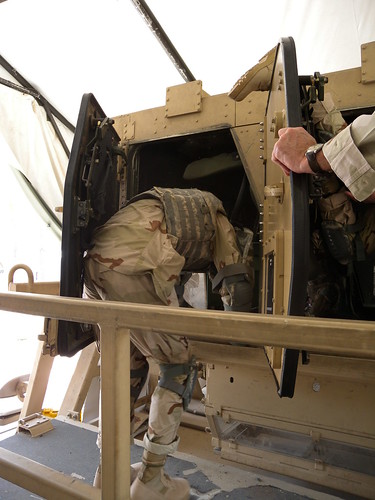
Day 4:
Our first day on the range, we started off with M9 quals. Yep. The first thing we did with real ammo was qualify on the M9. This was bad for people required to qual on the M9 who have never shot a handgun before. This was the Navy qualification course and it was in full battle rattle (Integrated Body Armor and ACH). I'm just glad I pulled off the expert marksman qualification. It would have been embarrassing if I didn't, since I was an pistol instructor (M1911 handguns) back at the Naval Academy so many years ago. It may have helped that I bought an M9 (Beretta 92FS) a few months ago and put 500 rounds downrange to get the feel for it. I was also smart enough to practice some of the finer points of the Navy qualifications.
Then we dropped our battle rattle in platoon formation (OK, we dropped it anywhere we felt like it and they made us move it into platoon formation) and proceeded to group and zero our M16/M4's "slick". This would be the last time we shot without armor. Did I mention armor is heavy? Shooting prone in the armor can be very difficult, too. The ACH tends to get pushed down over your eyes.
The next day we headed out to LOMAH. This is a computerized instant feedback range. We were shooting popup targets at various ranges out to 300 meters. Using sensitive microphone arrays, they are able to track the flight of your round and show you on a screen where you are hitting (or missing).
Sadly, we weren't shooting the whole time we were on the range. There is a lot of "white space". They try to fill it with concurrent training, which is a good thing. Looking back, it really seems the first two weeks are focused on shooting. There were a few things here and there that weren't, but not many. It may not help that we had one and a half range days wasted by power outage. The first day they didn't get power back until noon. We had already taken buses back to Camp McCrady. So...we got back on the buses and went to shoot. The next day it happened again. Instead of busing back to McCrady, we stuck around...and the power never came back on. This was qualification day. It also happened to be the coolest day in the first two weeks. It would have been ideal to qualify. It was "great" weather and the qualification process sounded fun - pop up targets at ranges from 50 to 300 meters.
These pictures were from the pre-qualification range. The DSs were of the opinion that whatever score you got here, you could probably add 5 or 6 to figure out how you would do for final qualification. The reason? Two things. First, the targets were spread out more. There's a lot more left and right, making it harder to recognize certain targets popped up. This is especially true with the 50m gimmes. The second is the contrast. All of these targets are dark. That makes it harder to see and aim at some of the more distant targets. I got over 30 on two out of three rounds. Things were looking good for qualifications.
Instead we ended up coming back and qualifying on Alt "C". Alt "C" is the alternate qualification method. Take the targets that are part of the normal qual range, and put appropriately proportioned facsimiles on a paper target at 25 meters. Some say it is easier. I thought it was less engaging and less realistic, and therefore it garnered less attention from those of us who were not required to qualify on the M16.
In fact...every day that we went to the range, we were at heat category 5 before we got to pull a single M16 trigger. That would also be known as "black flag". You can guess how comfortable it was to wear full body armor in 95-100 degree heat that is up near 110 with the heat index. The washer and dryer in our barracks worked until after lights out every day so we weren't hanging any soaked uniforms up. We're men, but we didn't want the barracks to smell like a locker room. Take a look at the thermometer ;)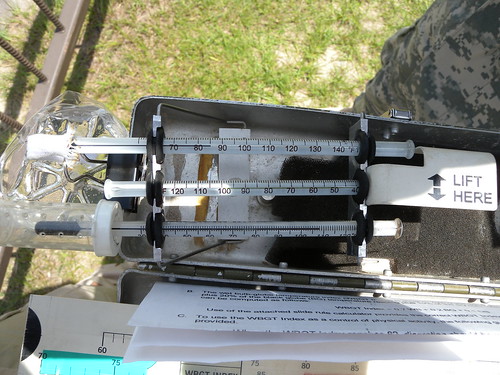
Somewhere in the rifle range white space, they had us in a classroom at the end of the day and taught basic "commo". We got a quick intro on setting up a SINCGARS radio and how to create and send a couple of signals (9 line medevac, and SPOT/SALUTE). The next week we had a practical application where we were broken up into teams of two and had to remember how to set up the radio, create the 9 line, and send it.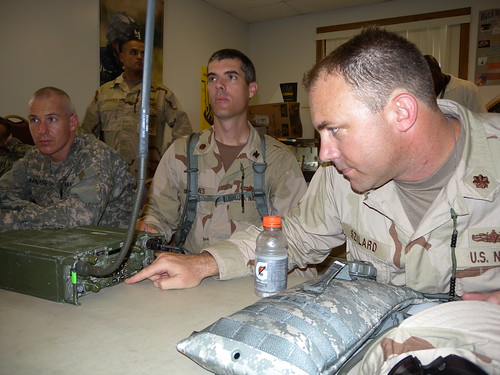
Once we got that done, we were given verbal directions on how to put on our JList. That's MOPP gear for the Navy types. For everyone else, that's our chemical, biological, radiological warfare suits. We had 3-5 seconds to put on our gas masks, then up to 8 minutes to put the suits on. It's Army Easy, so I was done in less than 3 minutes. My training at Ft McClellan in 1996 may have helped here, too.
Somewhere in week two we did the M9 Stress Fire (aka Table 3). This started with running in place 30-60 seconds. Then you have to pay attention and shoot the targets in the order the DS gives you (three targets to be engaged up to four times per position). You have one 6 round magazine loaded, and two in ammo pouches on your armor.
The first position is standing with optional support from a post/wall - fire two shots into the targets as ordered.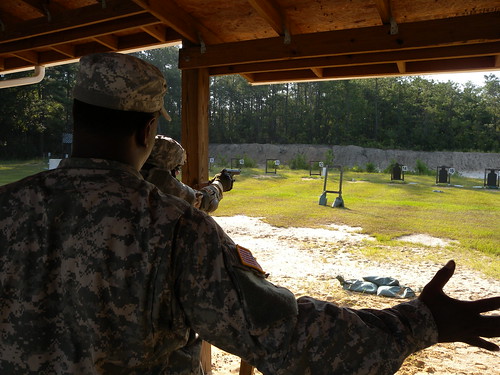
Then you transition to the prone where you fire four shots, rapid combat reload.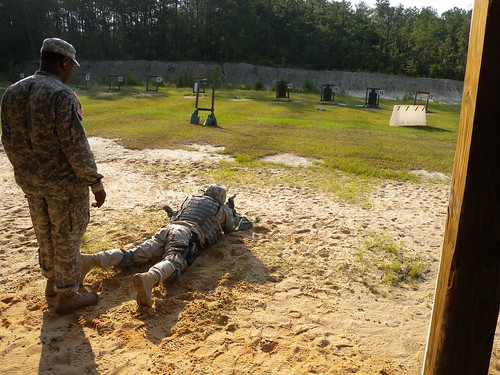
Move from here to the window, shooting through the window frame without "flagging" your position. This means you and the weapon stay "inside" the room so no one outside can see the weapon and possible pull it or you through the window. Shoot four shots through the window.
Next transition is to the barrier. Fire two shots over or around the barrier while taking cover. Combat rapid reload, then take two more shots.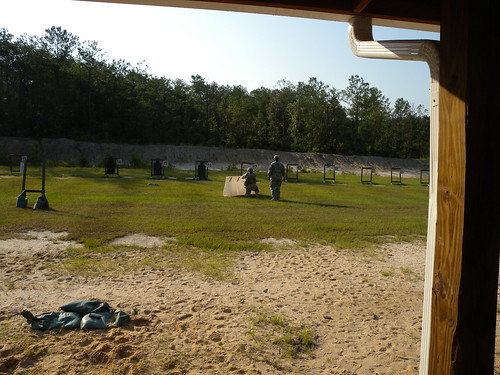
Transition from here to three meters from the targets, and from a standing position fire four point blank shots into the targets in the order given...usually finished with a double tap.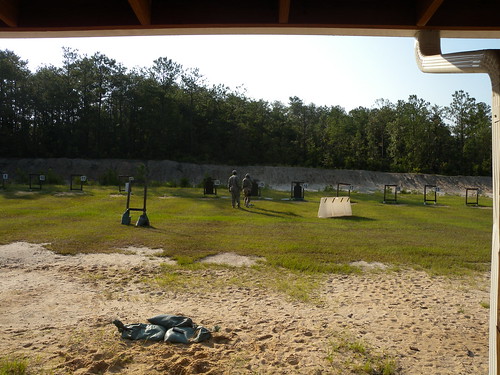
Here's a video I took:
The last things we did on the range were the M16 Stress Fire and the M16 Reflexive Fire. The M16 reflexive fire was relatively simple, but incredibly dangerous. 30 shooters line up on the range in groups of three. M16s are locked and loaded, carried at the low ready. At the range master's direction, you are told to face a certain way, then move as appropriate to engage the target with a controlled double tap using combat aiming - point the gun in the general direction and pull the trigger (you're close enough you shouldn't miss). We started facing straight and engaging the target by raising the rifle and shooting. Then we did a left face. Now the target was on our right. On the RM's command, we would engage the target. This means pivoting back to the front to keep the strength of our armor toward the threat, then raising the rifle and shooting. After firing two shots, we lower the rifle and pivot back to the left. If someone raises their rifle before pivoting the first time, or forgets to lower it before pivoting back, there may be a loaded rifle pointing at one of your body parts. Did I mention some of these people had never touched a gun before week one? Anyway, you go through this at different distances - 25 meters down to 5 meters.
The M16 Stress Fire was a little like the M9 Stress Fire...but more fun. We started by climing into and out of the back, then front, seats of the HMMVW (HumVee) they brought over. While in the HumVee, two of the DS's were yelling at us and making us "hurry".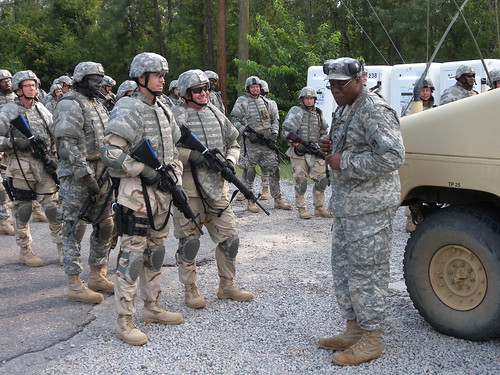
I may have had issues with keeping a straight face. USNA kept me from taking it too seriously.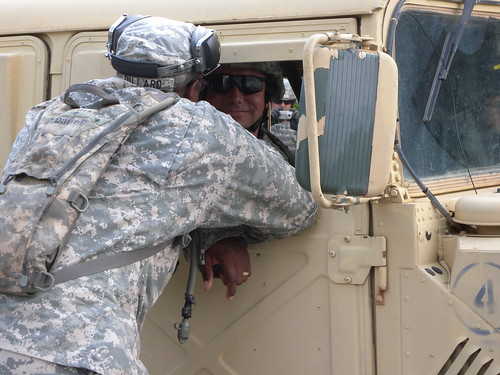
Coming out of the front seat, you had to sprint to a staging spot and take a knee. When the DS's with ammo were ready, you had to sprint there and take a knee. As they were giving you ammo that had to be put in cargo pockets, they were yelling and trying to cause stress. They were also prone to trying to take your weapon. If you let them, you got into a new world of hurt and had to do one or more things to get it back.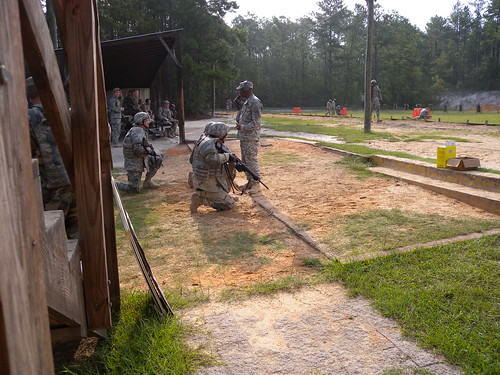
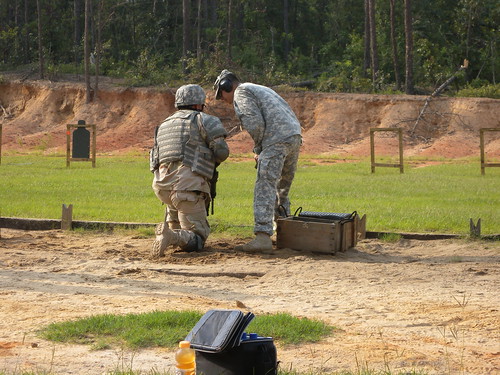
Once you got past these DSs, you headed to the first barrier. Here you engaged with two double taps from a standing position.
When safe, you proceeded to the next barrier. Shots here were from the prone position - two double taps.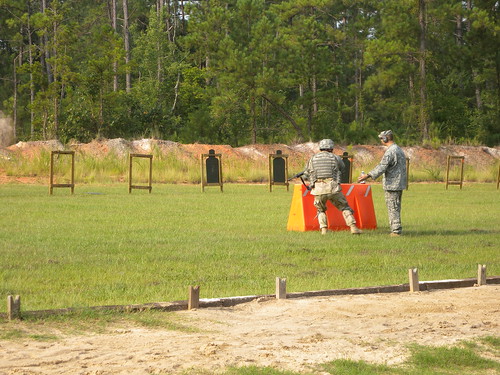
Now you moved to the next barrier, firing a double tap from the kneeling position followed by a rapid combat reload and another double tap. The final transition is to the last barrier where you unload the remaining rounds in controlled pairs. This was fun :) And, apparently I moved to fast. My photographer couldn't keep up and didn't get pictures of me at each station. I did, however, get a video of one of the other guys from getting ammo to empty.
The last week is all about the convoy. Front end training is on Monday, to include an IED "petting zoo" where you get to see different types of IEDs, learn what signs to look for, etc. You also get to do a training convoy with 5 HumVees per convoy. On the second convoy day, you do the convoy practical which can include IEDs, actors in appropriate clothing to act as both combatants and non-combatants, and other fun stuff.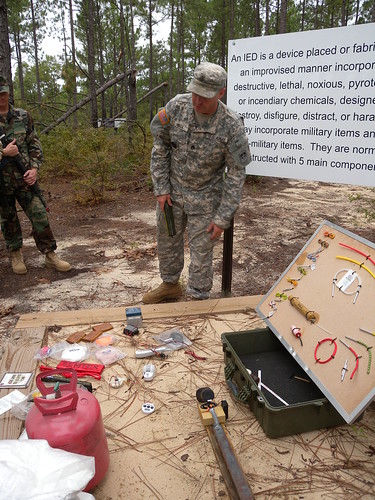
Then it's off to your next destination...Iraq, Afghanistan, or where ever the Narmy sends you.
I apologize for losing track of the days. I started off with good intentions to keep accurate dates...but it's close enough.
Individual Augmentee or IA
That's the name given to someone in the Navy going to Iraq, Afghanistan, or some other place to help out the other armed services. Well, it's my turn now. This post is the story of what it was like to make the 5 (or 7) day transition from reServist to Active Duty Navy. The story actually starts at Day -2, but that was uneventful. I'll start with Day 1.
Day 1:
Showed up by 0730 per the orders. Apparently some people got word to show up by 0545. Didn't have time to get uniforms fitted prior to heading to the auditorium for briefs (about 0815). There were a couple of times that groups were singled out to stay in the auditorium. Others were able to take a break during those times. I was in the group that had to stay at every break. Didn't get out of my seat until 1140 when they sent us to lunch to return by 1230. Did I mention most of the morning briefs were a rehash of the ECRC checklist?
After lunch we were told we could go get fitted for uniforms during the first brief. We waited for the fitting folks for about 20 minutes. After they got there and got started, we were told to do it the next day and head back to the auditorium. Maybe 10 people had been fitted at this point. Some of us opted, based on the morning briefs, to get fitted before going back. It seemed like a good choice.
A couple more briefs finished off the day, except for being broken up into our groups. We waited as a CS1 read off the four groups using everybodies last 4, and each person responded. They were then told whether or not they had to fast for a blood draw. A little tip...those who had the most to get done had a 0615 muster. The next group was 0630. Those of us who completed things ahead of time were given 0730.
Day 2:
Medical. Did I mention medical? You basically bounce around medical all day.
Day 3 and 4:
Check in at 0800. Go home. Oh...maybe get fit for a gas mask. Then go home.
Day 5:
Get your uniforms and your travel brief. We congregated in the courtyard of the BEQ until our uniforms were ready. Then we inventoried the sea bag of uniforms and ensured everything fit properly. The problem? No one knew just how the ACUs had to look, so some uniforms ended up being exchanged when we got to Ft Jackson.
Day 7:
We flew out of NAS North Island at 0845 on Sunday. We had a 0615 show time at NMPS to get transported by passenger van to NASNI. The flight was a USMC C-9. We landed in Topeka for fuel. We landed in P-cola to drop some people off (another group of PAX headed in the same general direction) and fuel. Then we landed in Columbia, SC, where one of our buses broke down so we had to wait for another. We got in to Camp McCrady after the DFAC closed, so we got bag lunches while we sat through some introductory presentations. Some time after 8pm, we made it to our barracks where we got to settle in and hope we could sleep...before the 0500 wake up for Monday morning.
That's enough for now. Thanks for reading if you're still here ;)
The next post will talk about the next two weeks and includes pictures. Heh.
Time flies
Wow...it's been a day or two since I posted anything here. There will be some to come about my last few weeks of Narmy training!!
Tuesday, September 8, 2009
More on Photography
In the past, I have posted once or twice about the photography podcast I follow called TWiP - This Week in Photography. It's from a family of podcasts based on TWiT - This Week in Tech. I happen to follow TWiT, TWiP, Windows Weekly and Security Now from that group. Lot's of good geek talk from the technical to the not so technical. For information on those, go to http://www.twit.tv/
One of the photographers on TWiP that has a ton of experience to share is Scott Bourne. For more info on him, check these links:
http://www.photofocus.com/
http://www.mydl.me/
He is also available on Twitter @ScottBourne
Now if I could just get back in the habit of posting here a little bit more...
A change to cursive writing?
I thought this was an interesting article!
http://www.nytimes.com/interactive/2009/09/04/opinion/20090908_opart.html
Monday, March 16, 2009
Karate Surprise
This year isn't going to be too good for me to compete in tournaments. I had just gotten back from Japan for the last one, so I wasn't up to competing. I won't be around for the one in May either. So Mama Lizard convinced me to compete this past Saturday.
Since three out of four little Lizards were in the tournament as well, I had a lot of time to chat with some of the sensei's. Sensei #2 heard me make a comment about being very competitive and asked if I was willing to compete a level higher with all of the brown belts. I said "Sure, why not?"
Kata competition went slightly better than expected, with me getting third. OK, so there were only four people competing, but I beat a master brown belt to get third.
Weapons kata went OK. I got second...out of two. I lost to a different master brown belt.
Sparring was the last event. Did I mention that I drew the low number, so I got to go first in kata and sparring? Anyway, I beat one of the master browns in the first match. The other mastwer brown beat the 2nd degree brown belt in their match. That put me up against him. We went a while, but in the end I beat him as well.
Fast forward to today. Mama Lizard went in to open workout with our Master (Sensei #1) today (she goes to open workout, I go to regular workout on Monday's). They got to talking and he made a comment along the lines of "We can't have a green belt beating brown belts in a tournament". Apparently I was on an accelerated pace to brown belt all of a sudden. He also suggested we prep Little Miss who had been advancing along with me.
So at 7pm I got to class and class was good. We started learning a new bo kata today. At the end of class we were lined up to bow out when Sensei #1 told us to spread out again. He and a 2nd degree black belt went in the back after Sensei told me I had one more thing to do tonight. I did not believe that I would be "tested" for brown belt like this.
They came out with some boards. The 2nd degree was holding one and Sensei said to break it. I've never done this before, but I gave it a whack. Literally ;) It broke quite nicely with a palm strike.
Then Sensei handed him two more boards and told me to break them both. He gave me the option of punch, elbow or kick this time. The palm strike worked before, so I did it again. The 2nd degree gave me my "kindling" to take home.
Sensei had us line up again, then called in all of the black belts who were waiting for their class after ours. They lined up at the front across from us.
Then I was called out "front and center" where a 3rd degree black belt pulled a brown belt from inside her gi (uniform) and Sensei announced "Advancing to 3rd Kyu, first degree brown belt, The Lizard". OK, they don't really call me the Lizard, but they might as well.
We went through the ceremony and now I'm a belt higher. It's a good thing we talked to Little Miss this afternoon, because we aren't the kind of people to hide things from our kids - except presents for later ;)
Now to catch up on all of the things I should know already but don't...
Labels: karate promotion